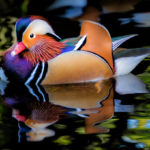ForumIAS announcing GS Foundation Program for UPSC CSE 2025-26 from 19 April. Click Here for more information.
ForumIAS Answer Writing Focus Group (AWFG) for Mains 2024 commencing from 24th June 2024. The Entrance Test for the program will be held on 28th April 2024 at 9 AM. To know more about the program visit: https://forumias.com/blog/awfg2024
What is the News?
Mandarin ducks appeared after 118 years in the Maguri-Motapung beel in Assam’s Tinsukia district.
Mandarin Duck:
- It is provided with a tag of the most beautiful duck in the world. Swedish botanist, physician, and zoologist Carl Linnaeus first spotted and identified this bird in 1758.
Key Characteristics of Mandarin Duck:
- Features: Male mandarins are colorful compared to females. Males have elaborate plumage (feathers) with orange plumes on their cheeks, orange ‘sails’ on their back, and pale orange sides. On the other hand, females are dull in comparison, with grey heads, brown backs, and white eyestripe.
- Feed on: These birds feed on seeds, acorns, small fruit, insects, snails, and small fish.
- Habitat: Its habitats include temperate forests near wetlands including rivers, streams, bogs, marshes, swamps, and freshwater lakes.
- Distribution: It is native to East Asia but has established populations in Western Europe and America too. It breeds in Russia, Korea, Japan, and the northeastern parts of China.
- India: The duck does not visit India regularly. It is because India is not on its usual migratory route. It was recorded in 1902 in the Dibru river in the Rongagora area in Tinsukia (Assam). More recently, it was sighted in Manipur’s Loktak Lake in 2013 and in Savoini Beel in Manas National Park in Assam in 2014.
- IUCN Red List: Least Concern.
Maguri Motapung Beel
- It is a wetland and lake located near to Dibru-Saikhowa National Park in Assam. It serves as a natural home to wildlife. Furthermore, it is also a source of livelihood for the local communities.
- Important Bird Area: It was declared as an Important Bird Area by the Bombay Natural History Society.
- Significance: The wetland is very important. It is home to at least 304 bird species, including a number of endemic ones like Black-breasted parrotbill and Marsh babbler.
- Concerns: In 2020, a blowout and fire at an Oil India Limited-owned gas well affected this wetland adversely. The resulting oil spill killed a number of fish, snakes as well as an endangered Gangetic dolphin.
Source: The Hindu





